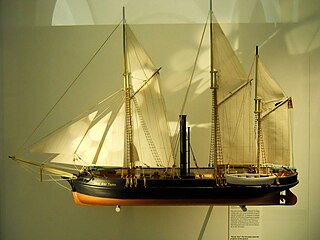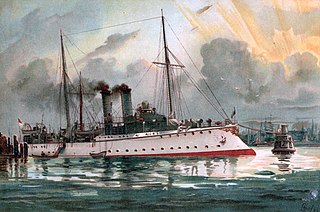
Ernst August was a wooden paddle steamer and corvette in the navy of the German Confederation, named after Ernest Augustus, King of Hanover.

Ernst August was a wooden paddle steamer and corvette in the navy of the German Confederation, named after Ernest Augustus, King of Hanover.
She had a 580 tonne displacement and was 49.21 m long along the waterline and 55.47 m long in total. At her widest point she was 9.72 m and across her wheel arches she was 17.1 m wide. Her maximum draught was 3.96 m and her propulsion were two paddle wheels driven by two horizontal single-cylinder reciprocating steam engines manufactured by Miller Ravenhill, a London firm. The engine produced about 950 PSi and gave her a speed of 9 knots. Each wheel had twelve blades and a diameter of 5.79 m. The engines supplied three boilers generating around 1 atm steam pressure, housed with the engines themselves in a 16.15 m long engine room. She carried 200 tonnes of coal to power the engines, but was also rigged as a two-masted schooner. Her armament was six 68-pounder guns and her crew was five officers and 145 NCOs and men. [1] Großherzog von Oldenburg and Frankfurt were built to the same design.
She was built by the shipbuilder William Patterson in Bristol for the German Confederation. She was launched as Cora in 1848 - the exact date is unknown. She cost 150,000 taler. [1] Under a British flag she sailed to Bremerhaven, where she was transferred to the German Confederation and renamed Ernst Augustus, entering service in October 1848. According to Lüder Arenhold, she was "a very nice model" ("ein sehr hübsches Modell") and according to several contemporary sources the most beautiful ship in the German fleet. She is said to have reached 11 knots during her proving trials. [2]
On 12 December 1852 she was auctioned at Brake, Lower Saxony and bought by the London-based General Steam Navigation Company, which renamed her Edinburgh and from March 1853 used her for voyages to Europe. In March 1855 she travelled to Varna, Bulgaria and the Ottoman Empire, where she was lost under unknown circumstances. Varna was then a logistics centre for Turkey, France and Britain whilst they fought the Crimean War and so Edinburgh seems to have been serving as a transport ship.

German submarine U-2 was a Type IIA U-boat of Nazi Germany's Kriegsmarine. Her keel was laid down 11 February 1935 by Deutsche Werke of Kiel as yard number 237; she was launched on 1 July and commissioned on 25 July 1935 with Oberleutnant zur See (Oblt.z.S.) Hermann Michahelles in command.

Von der Tann was a steam-powered 120 ton gunboat built in 1849 at Conradi shipyards in Kiel for the small joint navy of the two duchies of Schleswig and Holstein. She was the first propeller-driven gunboat in the world.
German submarine U-1059 was a Type VIIF transport submarine of Nazi Germany's Kriegsmarine during World War II.
German submarine U-1302 was a Type VIIC/41 U-boat of Nazi Germany's Kriegsmarine for service in World War II. She was commissioned on 25 May 1944.
SMS V48 was a 1913 Type Large Torpedo Boat of the Imperial German Navy during World War I, and the 24th ship of her class.

The Reichsflotte was the first navy for all of Germany, established by the revolutionary German Empire to provide a naval force in the First Schleswig War against Denmark. The decision was made on 14 June 1848 by the Frankfurt Parliament, which is considered by the modern German Navy as its birthday.

German submarine U-1022 was a Type VIIC/41 U-boat of Nazi Germany's Kriegsmarine. She was laid down on 6 May 1943 by Blohm & Voss in Hamburg, Germany, and commissioned on 7 June 1944, the day after the Allied landings in Normandy, with Kapitänleutnant Hans-Joachim Ernst in command. She sank two ships for a total of 1,720 metric tonnes. After the war she was handed over to the Allies and sunk in Operation Deadlight.
SMS V107 was a torpedo boat of the German Kaiserliche Marine. Originally ordered for the Dutch Navy from the German A.G. Vulcan shipyard as the Z-3, the ship was taken over by Germany during construction owing to the outbreak of the First World War. She was launched on 12 December 1914 and sunk by a mine in Libau harbour on 8 May 1915.
German submarine U-332 was a Type VIIC U-boat of Nazi Germany's Kriegsmarine during World War II. She saw service in the Atlantic Ocean and Mediterranean Sea. Built in 1941 and 1942 at Nordsee-Werke, Emden, U-332 was a Type VIIC U-boat, capable of lengthy ocean patrols and of operating in distant environments.
German submarine U-304 was a Type VIIC U-boat of Nazi Germany's Kriegsmarine during World War II. She saw service in the Atlantic Ocean and Mediterranean Sea. Built in 1941 and 1942 at Flender-Werke, Lübeck, U-304 was a Type VIIC U-boat, capable of lengthy ocean patrols and of operating in distant environments.

SMS Iltis was the lead ship of the Iltis class of gunboats built for the German Kaiserliche Marine in the late 1890s and early 1900s. Other ships of the class are SMS Luchs, SMS Tiger, SMS Eber, SMS Jaguar, and SMS Panther.
SMS G113 was an S90-class torpedo boat built for the German Kaiserliche Marine in the 1900s
SMS V4 was a V1-class torpedo boat of the Imperial German Navy. The ship was built by AG Vulcan, completing in 1912. She served in the First World War and was sunk at the Battle of Jutland on 1 June 1916.
SMS S31 was a 1913 Type Large Torpedo Boat of the Imperial German Navy. Commissioning in August 1914, she served during World War I and was sunk by a mine during the Battle of the Gulf of Riga on 19 August 1915.

SMS S115 was a S90-class torpedo boat of the Imperial German Navy that served during the First World War. The ship was built by Schichau at Elbing in Prussia, and was completed in February 1903. The ship was sunk during the Battle off Texel on 17 October 1914.

SMS S119 was a S90-class torpedo boat of the Imperial German Navy that served during the First World War. The ship was built by Schichau at Elbing in Prussia, and was completed in September 1903. The ship was sunk during the Battle off Texel on 17 October 1914.
SMS S32, was a torpedo boat of the Imperial German Navy. She was built in 1886 by Schichau at Elbing, as one of a large number of small torpedo boats of similar design built for the German navy. S32 was sunk in a collision with the torpedo boat S76 in the Baltic Sea on 17 August 1910.

SMS Nix was the lead ship of the Nix class of avisos built for the Prussian Navy in the early 1850s. After commissioning in 1851, Nix saw little activity, apart from short training exercises and cruises in the Baltic Sea, which were frequently punctuated with boiler fires. Dissatisfied with these incidents, the Prussian Navy decided to sell both of the Nix-class ships. In 1855, the ship was sold to the British Royal Navy in exchange for the sail frigate Thetis and was commissioned as HMS Weser. She saw action during the Crimean War at the Battle of Kinburn in October 1855, and thereafter saw little activity, being based in Malta. She was ultimately decommissioned in 1865, used as a harbor ship, and then sold to ship breakers in 1873.

The Nix class was a pair of avisos built for the Prussian Navy in the early 1850s. The class comprised two ships: SMS Nix and Salamander. They were ordered as part of a modest program to strengthen the fleet at the urging of Prince Adalbert of Prussia in the immediate aftermath of the First Schleswig War, which had demonstrated that the weak fleet could not challenge the ability of Denmark to impose a blockade of Prussian and German ports. They were small vessels with a shallow draft, since they were intended to operate close to shore to defend Prussia's coast. Neither vessel saw significant service in the Prussian Navy before being sold to the British Royal Navy in exchange for the frigate Thetis in 1855. They were renamed Weser and Recruit, respectively, and the former saw action during the Crimean War in the Black Sea later in 1855. The two ships saw little activity after their sale to Britain, with Recruit being laid up in 1861 and Weser following in 1865. Recruit was sold for merchant service in 1870, while Weser was discarded in 1873.
SMS S116 was a S90-class torpedo boat of the Imperial German Navy that served during the First World War. The ship was built by Schichau at Elbing in Prussia, and was completed in March 1903. The ship was torpedoed and sunk by the British submarine E9 on 6 October 1914.